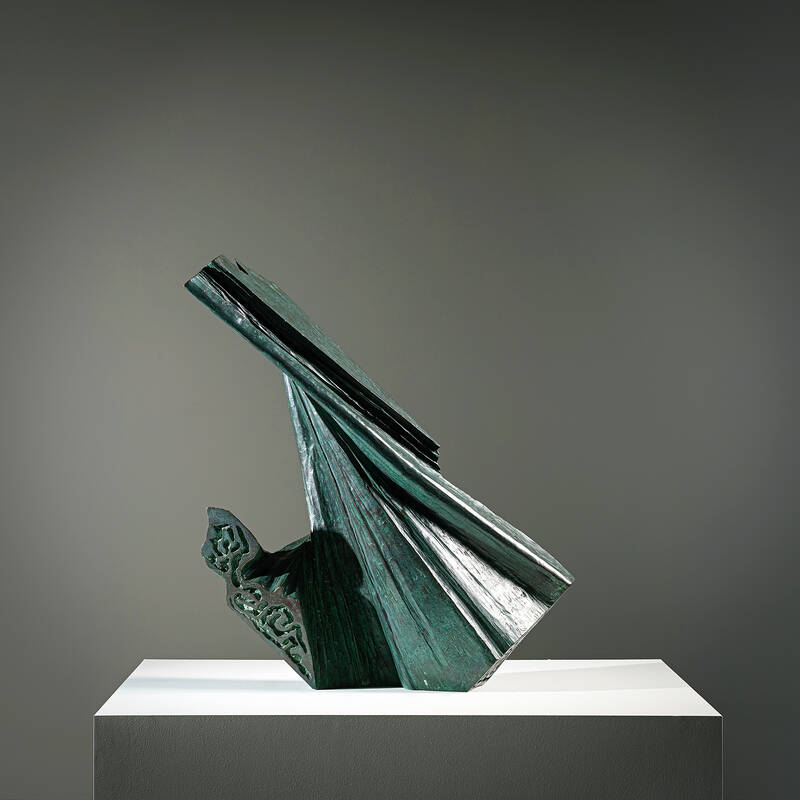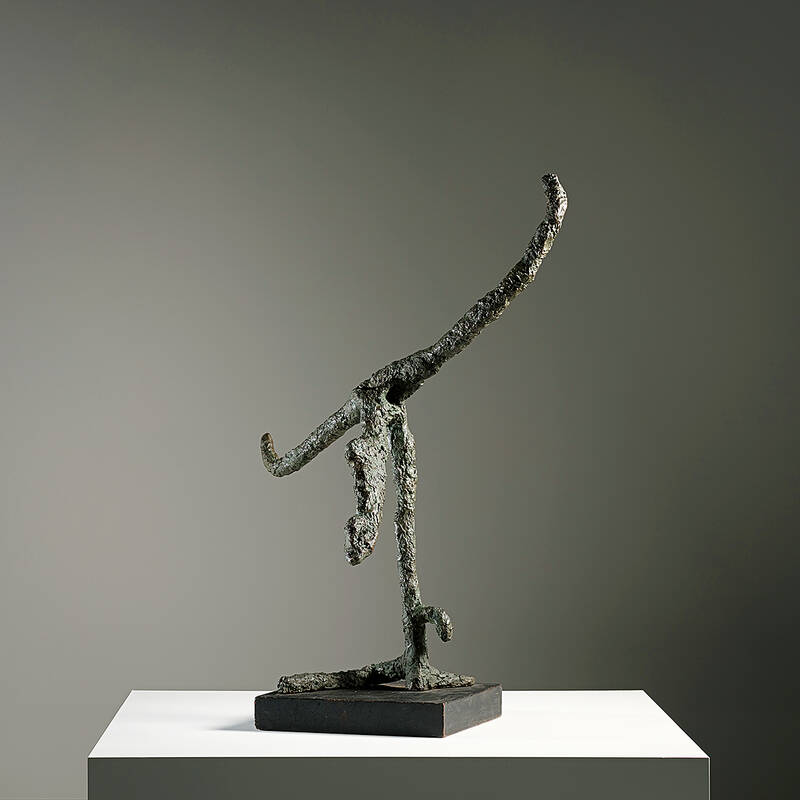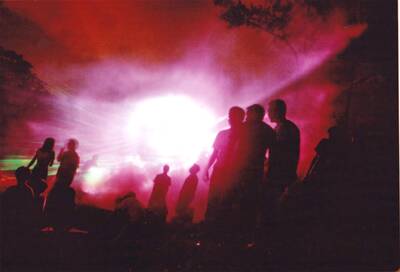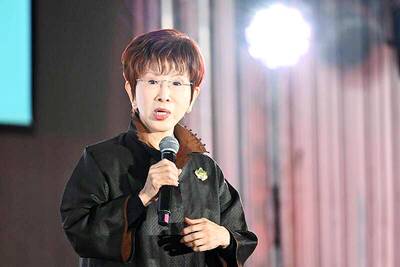An alluring artwork sits on the floor in the center of Asia Art Center’s gallery.
Jade-colored and made from bronze, it looks like an AI device has been tasked to print a 3D sculpture of a classical ink painting.
The bronze has been folded like silk and the lines engraved in it look like a fantastical ancient script.

Photo courtesy of the Asia Art Center
“This piece is from the Taroko landscapes series,” says curator Yang Ya-chu (楊雅筑). “It’s called simply Taroko Gorge.”
On hearing the name, all becomes clear: The silky folds are the crevices of mountainsides; the empty space bisecting the work is a valley; the swirling lines are clouds.
What makes the sculpture so absorbing is that it offers gallery-goers the perspective of the gods.

Photo courtesy of the Asia Art Center
TAIWAN INSPIRED
Yuyu Yang (also known as Yang Ying-feng, 楊英風) would live in various cities, from Tokyo to Rome. He was associated with post-war artists like the Fifth Moon Group (五月畫會).
Yet it was his upbringing in Taiwan’s “wild east,” that set him apart from his contemporaries.
Born in Yilan (宜蘭) in 1926, his rustic childhood cultivated a lifelong love of the natural world.
His naturalists sensibilities, combined with his Buddhist faith and a deep appreciation of art from the China’s Six Dynasties period (220-589CE), would inform his unique style.
The Taroko Landscape Series began in 1969 after he was invited by the director of the Hualien Veterans Marble Factory to work as a consultant.
Yang was deeply impressed by the majesty of the region — its grandeur and spirit inspiring the art he’d continue to create over the following decade.
The series includes standout pieces such as the Tower of Dreams and Moving Sleeve, which are said to “combine the ruggedness of mountain formations with the elegance of the flowing sleeves from Peking opera.”
ARTISTIC LIFE
The exhibition coincides with Yuyu Yang: A Centennial Art Retrospective, which is concurrently on display at Taipei’s National Taiwan Crafts Research Institute, which is part of the National Museum of History (國立歷史博物館), which it is next to.
Covering three floors, the exhibition chronicles all the stages of his long and productive career.
Yang spent his teenage years in Beijing in the 1940s; worked for 11 years as the art editor of Harvest during which time he “visited numerous rural townships and villages throughout Taiwan” studying folk customs; and embarked on a three-year study tour in Europe.
The exhibition presents art from all these periods and more. The range is truly extraordinary.
“Yuyu Yang used so many materials and explored so many ideas, he’s a challenge to curate,” says Yang Ya-chu.
From early pencil sketches and magazine illustrations to wood prints, nude photography and his huge “Landscape Sculptures” — impressionistic public artworks that point to “the interaction of humans, art and the environment” — Yuyu Yang did it all.
But it is arguably his middle-period work created on his return from Italy that encapsulates the topography and culture of Taiwan most eloquently.
The Calligraphy Series, articles of which are on display in both Asia Art Center and the National Museum of History, is truly exquisite.
A particularly evocative piece from this series is titled simply Strength.
“One of favorite subjects was the water buffalo,” Yang Ya-chu tells the Taipei Times.
The image of the water buffalo, has, of course, been common to East Asian art since antiquity.
But it is Yang’s use of lines to portray the water buffalo’s inner determination and stubbornness that reveals just how groundbreaking his approach was, and why his work remains so recognizable and sought after to this day.

Cheng Ching-hsiang (鄭青祥) turned a small triangle of concrete jammed between two old shops into a cool little bar called 9dimension. In front of the shop, a steampunk-like structure was welded by himself to serve as a booth where he prepares cocktails. “Yancheng used to be just old people,” he says, “but now young people are coming and creating the New Yancheng.” Around the corner, Yu Hsiu-jao (饒毓琇), opened Tiny Cafe. True to its name, it is the size of a cupboard and serves cold-brewed coffee. “Small shops are so special and have personality,” she says, “people come to Yancheng to find such treasures.” She

The low voter turnout for the referendum on Aug. 23 shows that many Taiwanese are apathetic about nuclear energy, but there are long-term energy stakes involved that the public needs to grasp Taiwan faces an energy trilemma: soaring AI-driven demand, pressure to cut carbon and reliance on fragile fuel imports. But the nuclear referendum on Aug. 23 showed how little this registered with voters, many of whom neither see the long game nor grasp the stakes. Volunteer referendum worker Vivian Chen (陳薇安) put it bluntly: “I’ve seen many people asking what they’re voting for when they arrive to vote. They cast their vote without even doing any research.” Imagine Taiwanese voters invited to a poker table. The bet looked simple — yes or no — yet most never showed. More than two-thirds of those

In July of 1995, a group of local DJs began posting an event flyer around Taipei. It was cheaply photocopied and nearly all in English, with a hand-drawn map on the back and, on the front, a big red hand print alongside one prominent line of text, “Finally… THE PARTY.” The map led to a remote floodplain in Taipei County (now New Taipei City) just across the Tamsui River from Taipei. The organizers got permission from no one. They just drove up in a blue Taiwanese pickup truck, set up a generator, two speakers, two turntables and a mixer. They

Former Chinese Nationalist Party (KMT) chairwoman Hung Hsiu-chu’s (洪秀柱) attendance at the Chinese Communist Party’s (CPP) “Chinese People’s War of Resistance Against Japanese Aggression and the World Anti-Fascist War” parade in Beijing is infuriating, embarrassing and insulting to nearly everyone in Taiwan, and Taiwan’s friends and allies. She is also ripping off bandages and pouring salt into old wounds. In the process she managed to tie both the KMT and the Democratic Progressive Party (DPP) into uncomfortable knots. The KMT continues to honor their heroic fighters, who defended China against the invading Japanese Empire, which inflicted unimaginable horrors on the